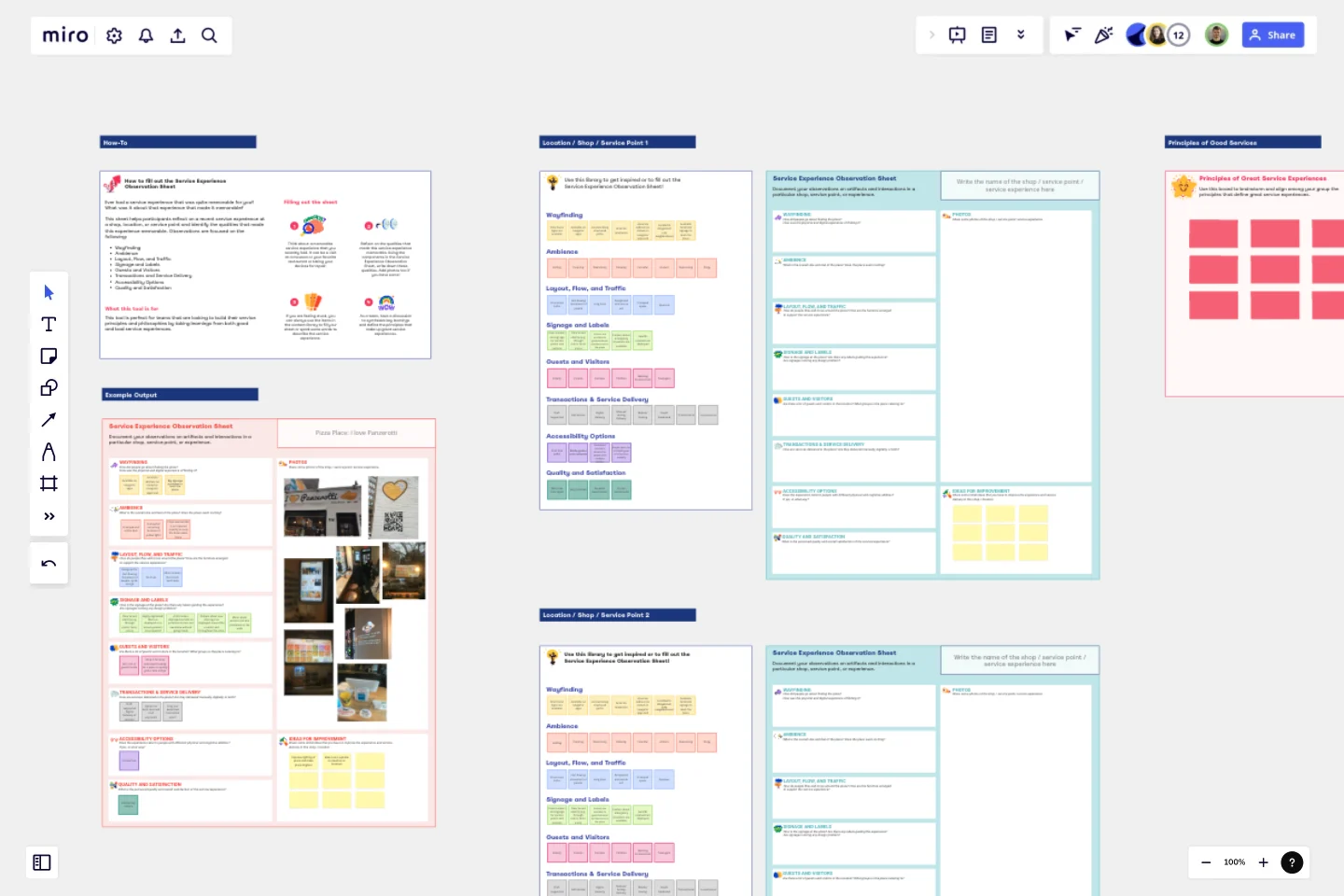Service Experience Observation Sheet
Ever had a service experience that was quite memorable for you? What was it about that experience that made it memorable?
This sheet helps participants reflect on a recent service experience at a shop, location, or service point and identify the qualities that made this experience memorable. Observations are focused on the following:
Wayfinding
Ambiance
Layout, Flow, and Traffic
Signage and Labels
Guests and Visitors
Transactions and Service Delivery
Accessibility Options
Quality and Satisfaction
This tool is perfect for teams that are looking to build their service principles and philosophies by taking learnings from both good and bad service experiences.
An example is also provided on the board to serve as a guide on how to fill out the sheet. You can also see a content library that contains example answers to the components in the sheet.
After participants have filled out their sheets, a group discussion is encouraged to synthesize key learnings and align on the principles that make up great service experiences.
This template was created by Aryanna Martin.
Get started with this template right now.
Look Mock Analyze Template
Works best for:
Design, Desk Research, Product Management
Doing your homework (aka, the research) is a key step in your design process, and the Look, Mock, Analyze approach helps you examine, structure, and streamline that step. With this powerful tool you’ll be able to identify your strengths and weaknesses, what you did right or wrong, and whether you spent time efficiently. Our Look, Mock, Analyze template makes it so easy for you to discover inspiration, mock up designs, and get feedback — you can start by setting up your board in less than a minute.
App Wireframe Template
Works best for:
UX Design, Wireframes
Ready to start building an app? Don’t just imagine how it will function and how users will interact with it—let a wireframe show you. Wireframing is a technique for creating a basic layout of each screen. When you wireframe, ideally early in the process, you’ll gain an understanding of what each screen will accomplish and get buy-in from important stakeholders—all before adding the design and content, which will save you time and money. And by thinking of things in terms of a user’s journey, you’ll deliver a more compelling, successful experience.
Empathy Map Trevotech
Works best for:
Market Research, Research & Design
Empathy Map Trevotech is a powerful tool for gaining insights into user experiences. It helps you capture and analyze user emotions, thoughts, and behaviors, ensuring your product designs meet user needs effectively.
Website Flowchart Template
Works best for:
Flowcharts, Mapping, User Experience
A website flowchart, also known as a sitemap, maps out the structure and complexity of any current or future website. The flowchart can also help your team identify knowledge gaps for future content. When you’re building a website, you want to ensure that each piece of content gives users accurate research results based on keywords associated with your web content. Product, UX, and content teams can use flowcharts or sitemaps to understand everything contained in a website, and plan to add or restructure content to improve a website’s user experience.
Website Landing Page Wireframe Template
Works best for:
Wireframe, UX, Design
The Website Wireframe template equips you with everything needed to kickstart your next website or web page concept. Rather than starting from scratch, the template offers a ready-to-use, customizable layout for your designs. Change and rearrange the included pages and components to build the perfect wireframe for your project.
Storyboard for Educational Purposes Template
Works best for:
Storyboard
The Storyboard for Educational Purposes template streamlines course creation by organizing content into scripts, screen text, and production notes. This template fosters collaboration among instructional designers and stakeholders, ensuring effective and engaging training modules. Perfect for educators and trainers, it enhances clarity, collects feedback, and improves overall learning outcomes by making content creation systematic and transparent.
